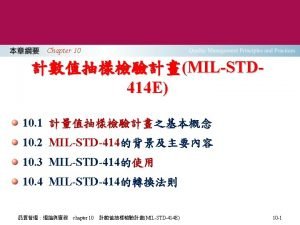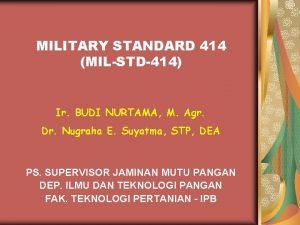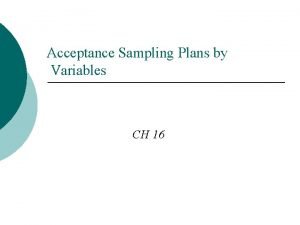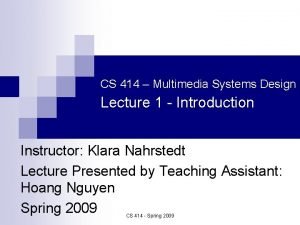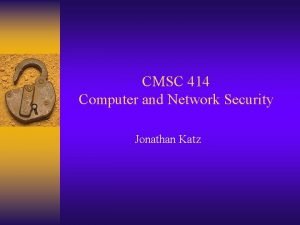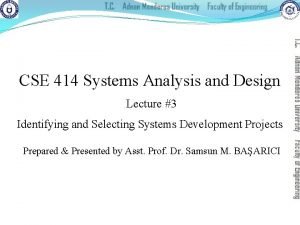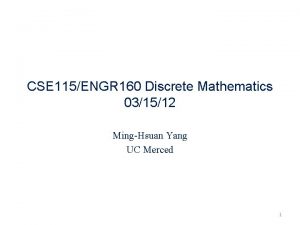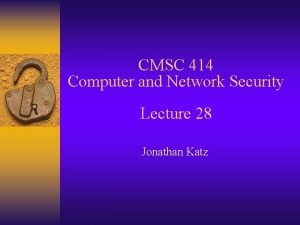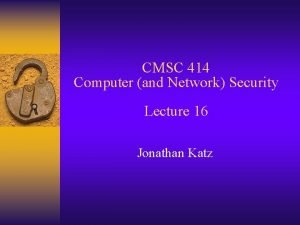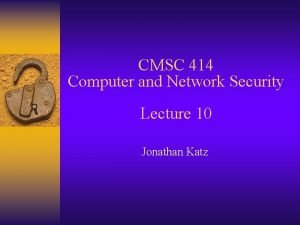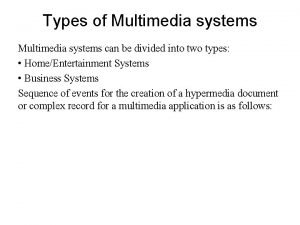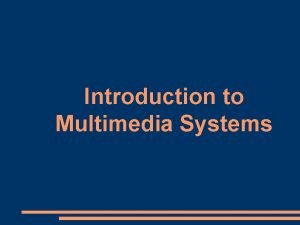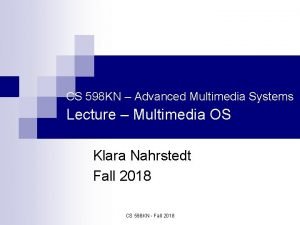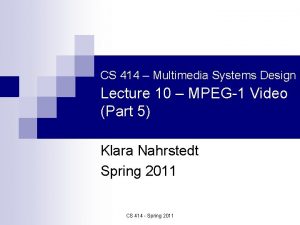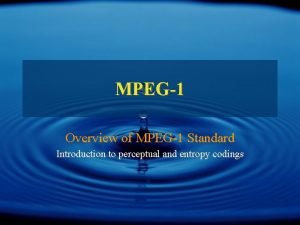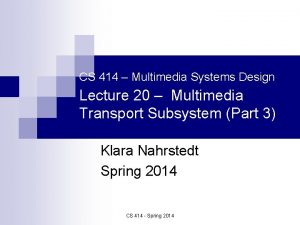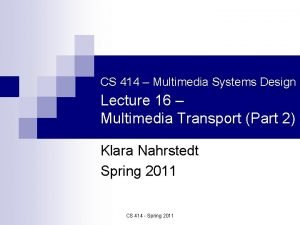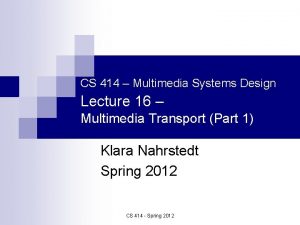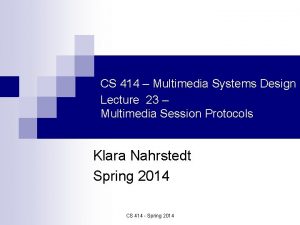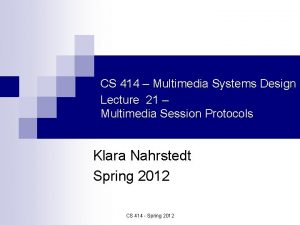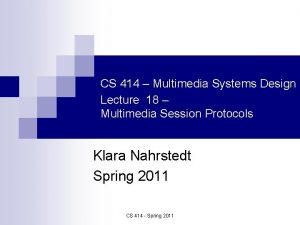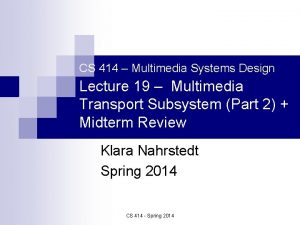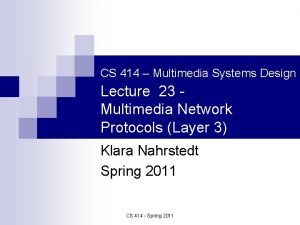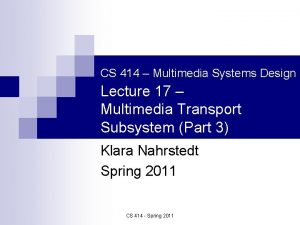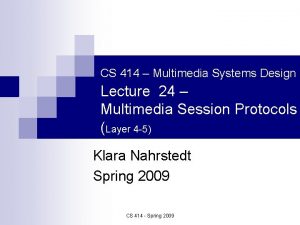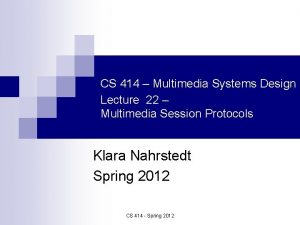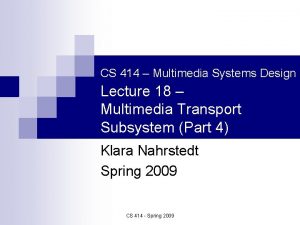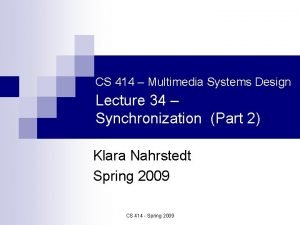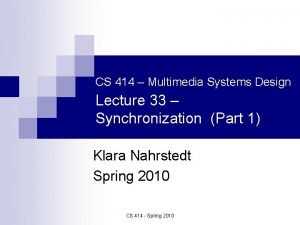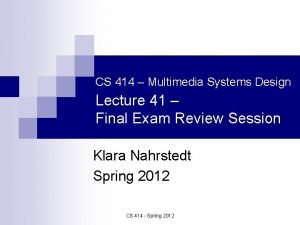CS 414 Multimedia Systems Design Lecture 10 MPEG1



























- Slides: 27

CS 414 – Multimedia Systems Design Lecture 10 – MPEG-1 Video a MP 3 Audio) (Part 5) Klara Nahrstedt Spring 2009 CS 414 - Spring 2009

Administrative n MP 2 was posted on Monday, February 9 th and deadline will be Monday, March 2 nd ¨ Please, start early – we will have two discussion sections for MP 2 ¨ The first discussion section will be on next Monday CS 414 - Spring 2009

Motion Picture Expert Group (MPEG) n General Information about MPEG ¨ Began in 1988; Part of Same ISO as JPEG MPEG-1/Video n MPEG/Audio – MP 3 n MPEG-2 n MPEG-4 n MPEG-7 n CS 414 - Spring 2009

MPEG General Information Goal: data compression 1. 5 Mbps n MPEG defines video, audio coding and system data streams with synchronization n MPEG information n ¨ Aspect ratios: 1: 1 (CRT), 4: 3 (NTSC), 16: 9 (HDTV) ¨ Refresh frequencies: 23. 975, 24, 25, 29. 97, 50, 59. 94, 60 Hz CS 414 - Spring 2009

MPEG Image Preparation (Resolution and Dimension) n MPEG defines exactly format ¨ Three components: Luminance and two chrominance components (2: 1: 1) ¨ Resolution of luminance comp: X 1 ≤ 768; Y 1 ≤ 576 pixels ¨ Pixel precision is 8 bits for each component n Example of Video format: 352 x 240 pixels, 30 fps; chrominance components: 176 x 120 pixels CS 414 - Spring 2009

MPEG Image Preparation Blocks Each image is divided into macro-blocks n Macro-block : 16 x 16 pixels for luminance; 8 x 8 for each chrominance component n Macro-blocks are useful for Motion Estimation n No MCUs which implies sequential noninterleaving order of pixels values n CS 414 - Spring 2009

MPEG Video Processing n Intra frames (same as JPEG) ¨ typically n Predictive frames ¨ encode n about 12 frames between I frames from previous I or P reference frame Bi-directional frames ¨ encode I from previous and future I or P frames B B P B B CS 414 - Spring 2009 I

Selecting I, P, or B Frames n Heuristics ¨ change of scenes should generate I frame ¨ limit B and P frames between I frames ¨ B frames are computationally intense Type Size Compress I 18 K 7: 1 P 6 K 20: 1 B 2. 5 K 50: 1 Avg 4. 8 K 27: 1 CS 414 - Spring 2009

MPEG Video I-Frames Intra-coded images I-frames – points of random access in MPEG stream I-frames use 8 x 8 blocks defined within Macro-block No quantization table for all DCT coefficients, only quantization factor CS 414 - Spring 2009

MPEG Video P-Frames Motion Estimation Method Predictive coded frames require information of previous I frame and or previous P frame for encoding/decoding For Temporary Redundancy we determine last P or I frame that is most similar to the block under consideration CS 414 - Spring 2009

Motion Computation for P Frames Predictive search n Look for match window within a given search window n ¨ Match window – macro-block ¨ Search window – arbitrary window size depending how far away are we willing to look n Displacement of two match windows is expressed by motion vector CS 414 - Spring 2009

Matching Methods n SSD metric n SAD metric n Minimum error represents best match ¨ must be below a specified threshold ¨ error and perceptual similarity not always correlated CS 414 - Spring 2009

Example of Finding Minimal SSD CS 414 - Spring 2009

Example of Comparing Minimal SSD and SAD CS 414 - Spring 2009

Syntax of P Frame Addr: address the syntax of P frame Type: INTRA block is specified if no good match was found Quant: quantization value per macro-block (vary quantization to fine-tune compression) Motion Vector: a 2 D vector used for motion compensation provides offset from coordinate position in target image to coordinates in reference image CBP(Coded Block Pattern): bit mask indicates which blocks are present CS 414 - Spring 2009

MPEG Video B Frames Bi-directionally Predictive-coded frames CS 414 - Spring 2009

MPEG Video Decoding Display Order I 1 B 2 P 1 B 3 B 4 P 2 B 5 B 6 P 3 B 7 P 3 B 5 B 6 I 2 B 8 I 2 Decoding Order I 1 P 1 B 2 P 2 B 3 B 4 CS 414 - Spring 2009 B 7 B 8

MPEG Video Quantization n AC coefficients of B/P frames are usually large values, I frames have smaller values ¨ Adjust quantization If data rate increases over threshold, then quantization enlarges step size (increase quantization factor Q) n If data rate decreases below threshold, then quantization decreases Q n CS 414 - Spring 2009

MPEG-1 Interchange Format Seq SC GOP SC Seq Video Bitstream Param Time Code PSC Type Buffer Param SSC Vert Pos Addr Type Motion Vector … QT, misc GOP Param . . . GOP Slice QScale MB CBP GOP . . . Pict Encode Param QScale Seq . . . b 0 Sequence Layer GOP Layer Picture Layer Slice Layer MB . . . CS 414 - Spring 2009 b 5 Macro-block Layer Block Layer

MPEG Audio Encoding n Characteristics ¨ Precision 16 bits ¨ Sampling frequency: 32 KHz, 44. 1 KHz, 48 KHz ¨ 3 compression layers: Layer 1, Layer 2, Layer 3 (MP 3) Layer 3: 32 -320 kbps, target 64 kbps n Layer 2: 32 -384 kbps, target 128 kbps n Layer 1: 32 -448 kbps, target 192 kbps n CS 414 - Spring 2009

MPEG Audio Encoding Steps CS 414 - Spring 2009

MPEG Audio Filter Bank n Filter bank divides input into multiple sub-bands (32 equal frequency sub-bands) n Sub-band i defined n - filter output sample for sub-band I at time t, C[n] – one of 512 coefficients, x[n] – audio input sample from 512 sample buffer CS 414 - Spring 2009

MPEG Audio Psycho-acoustic Model n n n MPEG audio compresses by removing acoustically irrelevant parts of audio signals Takes advantage of human auditory systems inability to hear quantization noise under auditory masking Auditory masking: occurs when ever the presence of a strong audio signal makes a temporal or spectral neighborhood of weaker audio signals imperceptible. CS 414 - Spring 2009

MPEG/audio divides audio signal into frequency sub-bands that approximate critical bands. Then we quantize each sub-band according to the audibility of quantization noise within the band CS 414 - Spring 2009

MPEG Audio Bit Allocation n n This process determines number of code bits allocated to each sub-band based on information from the psychoacoustic model Algorithm: 1. Compute mask-to-noise ratio: MNR=SNR-SMR n Standard provides tables that give estimates for SNR resulting from quantizing to a given number of quantizer levels Get MNR for each sub-band 3. Search for sub-band with the lowest MNR 4. Allocate code bits to this sub-band. 2. n If sub-band gets allocated more code bits than appropriate, look up new estimate of SNR and repeat step 1 CS 414 - Spring 2009

MPEG Audio Comments n n n Precision of 16 bits per sample is needed to get good SNR ratio Noise we are getting is quantization noise from the digitization process For each added bit, we get 6 d. B better SNR ratio Masking effect means that we can raise the noise floor around a strong sound because the noise will be masked away Raising noise floor is the same as using less bits and using less bits is the same as compression CS 414 - Spring 2009

Conclusion n MPEG system data stream Interchange format for audio and video streams ¨ Interleave audio and video packets; insert time stamps into each “frame” of data ¨ n Synchronization ¨ n SRC – system clock reference; DTS – decoding time stamp; PTS – presentation time stamp During encoding Insert SCR values into system stream ¨ Stamp each frame with PTS and DTS ¨ Use encode time to approximate decode time ¨ n During decoding Initialize local decoder clock with start values ¨ Compare PTS to the value of local clock ¨ Periodically synchronize local clock to SCR ¨ CS 414 - Spring 2009
 Difference between mpeg1 and mpeg2
Difference between mpeg1 and mpeg2 01:640:244 lecture notes - lecture 15: plat, idah, farad
01:640:244 lecture notes - lecture 15: plat, idah, farad Multimedia becomes interactive multimedia when
Multimedia becomes interactive multimedia when Difference between linear and nonlinear multimedia
Difference between linear and nonlinear multimedia Chapter 1 introduction to multimedia
Chapter 1 introduction to multimedia Esa multimedia.esa.int./multimedia/virtual-tour-iss
Esa multimedia.esa.int./multimedia/virtual-tour-iss Mil-std-414
Mil-std-414 Mil-std-414
Mil-std-414 Mil-std-414
Mil-std-414 Pc 414
Pc 414 Cs 414
Cs 414 Cmsc 414
Cmsc 414 Cse414
Cse414 Gcd of 414 and 662
Gcd of 414 and 662 Cmsc 414
Cmsc 414 Cmsc 414
Cmsc 414 Cmsc 414
Cmsc 414 Operating system lecture notes
Operating system lecture notes Articulators
Articulators Lecture sound systems
Lecture sound systems Types of multimedia
Types of multimedia Introduction to multimedia systems
Introduction to multimedia systems Advanced multimedia systems
Advanced multimedia systems Multimedia dbms
Multimedia dbms Eurocode lap lengths
Eurocode lap lengths Elemen urban design
Elemen urban design Interior design lecture notes+ppt
Interior design lecture notes+ppt Lecture hall acoustic design
Lecture hall acoustic design






